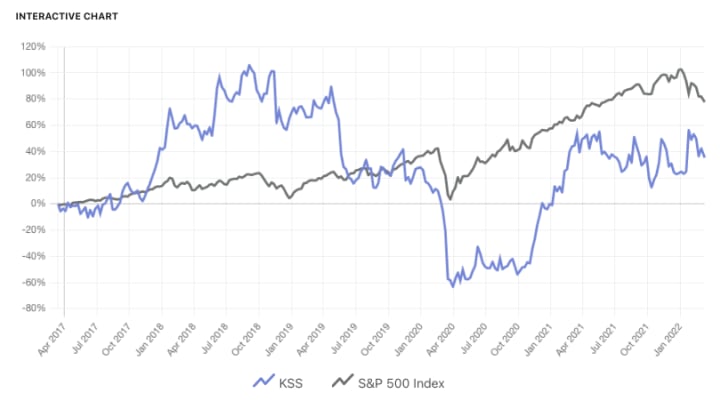Why Kohl’s Strategy of No Longer Wanting to Be Considered a Department Store Just Might Work
The CEO of the mammoth Kohl’s retail chain recently announced a strategy that might have, at first blush, sounded more like a fake news story from “The Onion.” But here’s why the company’s radical shift in strategy might enable the company to survive in the fast-changing retail marketplace.

Overview
If you were like me, you were scrolling Twitter a few days ago and suddenly the hashtag #Kohls was trending. In and amongst all the terrible and tragic news we face today coming out of Ukraine and the costly repercussions of the conflict here at home, one had to wonder just why the department store chain somehow managed to be trending on social media. Personally, my first thoughts were ones of fear that there had been yet another mass shooting in a retail store and of curiosity that maybe a Kohl’s employee had chosen to quit his or her job in a spectacular fashion (captured on video, of course) and that departure had gone viral.
But alas, neither of these were the case. In fact, what made Kohl’s, a staple of shopping centers all across America with over 1,100 stores in every state except Hawaii, which if you live in a major metropolitan area you likely have one of their locations within just a few miles of you right now, trend on social media was their announcement of a bold new strategy. The headlines on the stories about their new strategy sounded right out of the minds of the writers for the satirical news site, The Onion, reading like this:
- Kohl's Says It's No Longer a Department Store
- Kohl’s Now Claiming It’s No Longer A Department Store
- Kohl's to Undergo Reset, Says It’s No Longer Just a Department Store
At first blush, it would seem akin to a 7-Eleven, a Circle K or a Wawa announcing that they would no longer be a convenience store or a Dick’s or an Academy saying that they would not be a sporting goods store going forward. It would be like Pizza Hut or Papa John’s saying that they weren’t in the pizza business or McDonald’s, Burger King or Five Guys proclaiming that you should no longer think of them as being a place for hamburgers. Yes, we could go on and on and on with the analogies. However, the strategy that Kohl’s just announced might be one of the biggest strategic moves attempted in the history of retailing, and if it works, their shift might just save the company from the declines suffered by formerly stalwart national retail chains such as Sears, Kmart, JCPenney, Macy’s, Pier 1 and more in today’s rapidly changing retail environment. In fact, if the company can pull off this transformation, it could be one of the greatest escapes in the history of American business! In this article, we’ll examine the prospects for Kohl’s “We’re No Longer a Department Store” strategy to actually succeed, and what the company just attempting to do so - and maybe, just maybe, actually pulling this off - might mean for other consumer businesses today.

The Present Status of the Kohl’s Chain: Under Pressure
Kohl’s is a company under pressure. As we all know, the retail world is fast-changing today. The “Retail Apocalypse” took a heavy toll on legacy, brick and mortar retail giants, causing many established names to either fold and morph into online-only retailers. At the same time, online retailers, led by Amazon and Walmart, turned shopping online and having things - well, everything - into the default option for many American households. And then both COVID-19 and the “Great Resignation” hit in succession, making physical retail operations even more challenging than they had been when major retailers were focused primarily on how to compete with the growing threat from online shopping. The department store market was especially hard hit by all of this. And even as the major chains tried to ramp-up their online operations and create new ways of selling - and using their stores (including innovating with BOPIS [Buy online, pickup in store] and even shipping merchandise direct to customers from store locations [in effect, making the store inventory available online to customers everywhere], these retail giants - from Macy’s to Nordstrom to JCPenney to Belk to Saks Fifth Avenue to yes, Kohl’s, struggled to find a “winning” strategy in a vastly changed retail environment.
While Kohl’s has been regarded as, if not a retail success story, at least a retail survivor in the troubled department store sector…
…investors have been disappointed for years with the company’s financial performance (yes, famed Wall Street analyst Jim Cramer famously called Kohl’s “roadkill” in January 2020, even before the tumult the pandemic wreaked on the retail industry)!
In recent months however, Kohl’s has been not just under pressure, but under siege. While the retailer has survived the storm that has swept through the American retail environment, its stock has not performed well in comparison to the rest of the market. As can be seen in Figure 1 (Kohl’s Stock Market Performance, April 2017 - March 2022), while the company’s stock has recovered nicely from the start of the pandemic in
Figure 1: Kohl’s Stock Market Performance, March 2017 - March 2022

March 2020 (tripling since that point, in fact), over the past five years as a whole, the stock is only up by approximately a third, significantly underperforming the overall market by any measure, including the overall S&P 500. This has led to investor angst - and action. Today, the company has a group of investment firms (Macellum Advisors, Ancora Holdings, Legion Partners Asset Management and 4010 Capital) that together hold just under 10% of Kohl’s stock. To make a complex story short, they are pushing for the retailer to engage in selling many of its store locations and then leasing them back. This is a strategy that both Big Lots and Bed Bath & Beyond have successfully engaged in over the past year, bringing both the big-box retailers hundreds of millions of dollars to firm-up their balance sheets. The activist group of investors has recently put forward an alternative Board of Directors slate for Kohl’s…
… and the company has declined a buyout offer of over $9 billion dollars from a hedge fund tied to the firms pressuring Kohl’s to make changes.
So, with all of the market and financial pressures on Kohl’s, the company is definitely at a crossroads. What to do? Well, they are embarking - or really furthering - a unique strategy: Basically saying the mammoth department store chain will no longer be a department store!

The Kohl’s “We’re No Longer a Department Store” Strategy
Michelle Gass has been CEO of Kohl’s since 2018. Kohl’s has been pursuing innovative strategies with its stores since the beginning of her tenure. These have been focused on forming partnerships with leading companies that can help drive more traffic to their physical stores. Most notably, Kohl’s has teamed up with Amazon as a drop-off location for customers to return their online purchases to Amazon. The program, where kiosks are set-up inside Kohl’s stores for customers to make their returns, is now nationwide, and the retailer says that it has resulted in millions of new customers setting foot in their retail locations just for this purpose.
While the Amazon partnership takes up little physical space in Kohl’s retail stores, the company has been actively seeking to share the typically large footprint of its locations with retailers - and more - that will not just help drive additional traffic to Kohl’s, but create synergies between what these companies and what Kohl’s offers. The three primary partnerships in this vein undertaken by Kohl’s to date, all of which serve to shrink the size of a Kohl’s location by leasing part - often a significant part - of the store’s former total square footage, are:
- Aldi: In 2019, Kohl’s began a partnership with the grocery retailer to have it co-locate stores within the footprint of a Kohl’s store (with at least 10 such stores operating to date). The move is seen to position Kohl’s - and Aldi - to better compete with the supercenter stores of Walmart and Target.
- Planet Fitness: In like fashion, also in 2019, Kohl’s announced that in 10 of its locations, the retailer would lease 20-25,000 square feet of its former store space to Planet Fitness. The intent was that the co-location of the fitness center with the Kohl’s store would drive additional traffic to the retailer, specifically with customers seeking not just athletic apparel and shoes, but also electronic devices like fitness monitors and such.
- Sephora: Last year, Kohl’s announced a partnership with Sephora to have that company open a branded “store within a store” that would replace their former area that housed beauty products. Initially, the agreement had Sephora open 200 such stores within Kohl’s locations, and early analysis of store traffic showed a significant uptick in foot traffic within Kohl’s stores that had Sephora-branded “stores” in comparison to those locations that had legacy beauty departments, as well as demonstrating the ability to draw from a wider area than traditional, non-Sephora equipped Kohl’s location. Additionally, the early shopping metrics showed that roughly half of the customers that shopped in Kohl’s for Sephora beauty products also bought other merchandise within the wider store.
Now, as analysts have pointed out, the Kohl’s “shrinking its stores” strategy was not unique in the retail world, as both Macy’s and Target have been opening smaller footprint stores to better position themselves in a changing retail world - with the idea that “small is the new big in retail.”
The company recently announced that it will expand on its existing partnerships, heavily banking on Sephora, which will expand its presence to 75% of the company’s existing locations this year. In addition to further shrinking its existing stores, Kohl’s intends to open 100 new locations, which will average 35,000 square feet. While the company also announced that it would be ramping up its Kohl’s Cash program and other measures, the real headline was in regards to how it would be positioning the company going forward. The Kohl’s CEO announced that the retail chain is going “all in” on not just a store-shrinking strategy, but a tack that will seek to remake the Kohl’s brand. Specifically, Michelle Gass made headlines with the provocative pronouncement that Kohl’s should “no longer be regarded as a department store!” As she put it bluntly:
"We're evolving our position from a department store to a more focused lifestyle concept centered around the active and casual lifestyle."
—- Kohl's CEO Michelle Gass
And lest there be any confusion as to what her - and her company’s position is going forward, she added:
"Make no mistake, this is a transformation. It is a complete reinvention of our business model and our brand."
—- Kohl's CEO Michelle Gass
Kohl’s ambitiously wants to “hyper-localize” its stores to match the needs of consumers in local markets, matching not just the size of the store - but what it offers - based on the characteristics of the local buying population. In doing so, it hopes to use data to drive its decisions, and in the end, be able to attract new, younger consumers for whom shopping in a department store is something that their parents - or even their grandparents - do, but not themselves.

Analysis
Will this provocative strategy work for Kohl’s? Is it possible to remake your brand - and your perception of such by both existing and potential new customers - on the fly, when you are an established presence in most shopping centers across the country? Certainly, there are significant operational efficiencies from downsizing the traditional department store, jettisoning inventory that is slow moving (housewares, linens, fine jewelry, etc.) and bringing in more merchandise in athletic and fast-fashion that appeals to the younger shoppers that you are seeking to attract. Additionally, simply reducing the size of stores concomitantly reduces not just operating costs with utilities and such, but also the need for staff to adequately cover the reduced square footage of retail space. And yes, bringing in not just established brands and their followers (like Sephora and even Aldi and Planet Fitness) into - or now adjacent - to your store is likely to improve store traffic - and ultimately sales. So, from a strategy standpoint, the new Kohl’s strategy seems sound, not just for its existing stores, but for the new smaller stores that it seeks to create going forward. One could well imagine that they typical 100,000 square foot Kohl’s store today could - and maybe even should - look more like the new 35,000 square foot stores it is committed to opening over the next few years, whether that is accomplished by leasing out more existing space to partners like Aldi and Planet Fitness, forging new partnerships with brands that complement Kohl’s offerings, or simply leasing out unneeded space to other retailers (or perhaps other entities) simply seeking out what are undoubtedly some of the highest profile retail spaces out there today.
As a strategic management consultant and professor, I see this strategy either working out well for Kohl’s or alternatively, ending in disaster. On the positive side, Kohl’s management team is to be commended for coming out with a provocative strategy to counter not just the investor dissatisfaction with the company’s performance of late, but the overall trends in the retail world - and specifically with department stores - that are, too put it mildly, less than favorable to the company. There is a famous saying attributed to the famed business innovator and presidential candidate H. Ross Perot that goes that “if your business is in danger of being made obsolete, make sure that you are the one that does it!” And so all credit must go to Kohl’s CEO Michelle Gass for looking at the fast-changing retail landscape and realizing that the future for the “traditional” department store was quite limited. And yes, the company’s “we’re no longer wanting to be regarded as a department store” was not a radical departure from the strategies that they had been pursuing over the past few years. Rather, it was simply the culmination - and expansion - of what they had been doing. However, one must bear in mind that it is exceedingly difficult to change consumers’ perceptions of who you are and what you do as a company. Brand images and positioning are well-established, and these perceptions are very hard to change in the minds of consumers. So while it is all well and good to talk of not being a department store any more, guess what the average American consumer will continue to think of Kohl’s as for many years to come? If you said a “department store,” you are correct!
Thus, it will be incumbent on the company to follow through on its announced strategy and really try to become a different kind of retailer. From my consulting viewpoint, I would fully expect all Kohl’s locations to both downsize in square footage and lease out more space to its existing national partners - and likely even new ones on both the national and local levels - so that the average Kohl’s “store” would approximate the 35,000 square feet footprint of its planned new locations. The potential for both national and local “brand synergies” is very real, and in reality, in a world where online shopping with Amazon and more is a default “first option” for mamy, this is not just a prospect, but a necessity for Kohl’s to pursue to survive - let alone thrive - in the new, very different world of retailing today. But if you ask me, a Kohl’s store, featuring casual, athletic wear, sandwiched between an Aldi and a Planet Fitness, just might be the best path forward! While this may not be possible with most current Kohl’s locations, one could easily see co-locations of these existing branding partners - and perhaps more - helping Kohl’s to chart a new course forward, where yes, consumers may not perceive Kohl’s as a department store, but as a retailer striving to serve their unique needs. It is no doubt going to be a difficult road ahead for Kohl’s, and perhaps, the insurgent directors and the investment firm’s bids for control of the company may yet wrestle control of the chain from the current management. However, this unique “we’re not a department store” strategy for one of the few remaining national department store chains may, in time, prove to be a very successful one for Kohl’s!
++++++++++++++++++++++++++++++++++++++++++++++++++++
About David Wyld
David Wyld is a Professor of Strategic Management at Southeastern Louisiana University in Hammond, Louisiana. He is a management consultant, researcher/writer, publisher, executive educator, and experienced expert witness. You can view all of his work at https://authory.com/DavidWyld.
Social Media Links to David Wyld:
About the Creator
David Wyld
Professor, Consultant, Doer. Founder/Publisher of The IDEA Publishing (http://www.theideapublishing.com/) & Modern Business Press (http://www.modernbusinesspress.com)






Comments
There are no comments for this story
Be the first to respond and start the conversation.